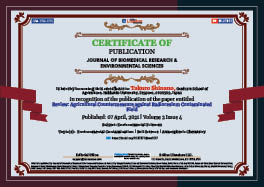Takuro Shinano*
Volume2-Issue4
Dates: Received: 2021-04-02 | Accepted: 2021-04-05 | Published: 2021-04-07
Pages: 228-231
Abstract
In 2011, Great East Japan Earthquake and subsequent tsunami caused severe damage on the TEPCO’s nuclear power plants in Fukushima prefecture. A large area of agricultural fields in Eastern Japan was suffered by substantial amount of radioactive materials (especially radiocesium) and tremendous efforts has been taken to remediate the contaminated fields. Though phytoremediation was expected to be effective to remove radiocesium, it did not work at least in this area. Actually physical decontamination was carried out, while it is still required to mitigate the transfer of the remaining radiocesium to the crops. For this purpose potassium application is adopted as a reliable method.
FullText HTML
FullText PDF
DOI: 10.37871/jbres1217
Certificate of Publication

Copyright
© 2021 Shinano T. Distributed under Creative Commons CC-BY 4.0
How to cite this article
Shinano T. Review: Agricultural Countermeasure against Radiocesium Contaminated Field. J Biomed Res Environ Sci. 2021 Apr 07; 2(4): 228-231. doi: 10.37871/jbres1217, Article ID: jbres1217
Subject area(s)
References
- Japanese Society of Soil Science and Plant Nutrition. Information related to Nuclear power plant accident and Tsunami attack. April 2021. https://bit.ly/3mltpV1
- Sato M. Verification of radiocesium removal by phytoremediation. Japanese Journal of Soil Science and Plant Nutrition. 2014;85(2):136-137. https://bit.ly/3cNXOIr
- Shinano T. Remediation of agricultural fields after TEPCO’s Fukushima Daiichi Nuclear Power Plant accident. Journal of Agricultural and Food Technology. 2020;16:2-5.
- Spezzano P. Distribution of pre- and post-Chernobyl radiocaesium with particle size fractions of soils. J Environ Radioact. 2005;83(2):117-27. doi: 10.1016/j.jenvrad.2005.02.002. PMID: 15923068.
- Tsukada H, Takeda A, Hisamatsu S, Inaba J. Concentration and specific activity of fallout 137Cs in extracted and particle-size fractions of cultivated soils. J Environ Radioact. 2008 Jun;99(6):875-81. doi: 10.1016/j.jenvrad.2007.11.014. Epub 2007 Dec 26. PMID: 18162267.
- Ministry of Agriculture, Forestry and Fisheries. April 2021. https://bit.ly/3cNZNfS
- Nuclear Emergency Response Headquarters. 2021 April. https://bit.ly/2Q0QPmv
- MAFF 2020. https://bit.ly/3mmmPOf
- Fukuhima prefecture and Ministry of Agriculture, Forestry and Fisheries. 2021 April. https://bit.ly/3wrh2eQ
- Kato N, Kihou N, Fujimra S, Ikeba M, Miyazaki N, Saito Y, et al. Potassium fertilizer and other materials as countermeasures to reduce radiocesium levels in rice: Results of urgent experiments in 2011 responding to the Fukushima Daiichi Nuclear Power Plant accident. Soil Science and Plant Nutrition. 2015;61(2):179-190. https://bit.ly/3sRRg1f
- Nakao A, Uno S, Kubotera H, Tanaka R, Root RA, Kosaki T. Distance-dependence from volcano for Asian dust inclusions in Andosols: A key to control soil ability to retain radiocesium. Geoderma. 2021;385:114859. https://bit.ly/3uAYZRV
- Eguchi T, Ohta T, Ishikawa T, Matsunami H, Takahashi Y, Kubo K, et al. Influence of the nonexchangeable potassium of mica on radiocesium uptake by paddy rice. Journal of Environmental Radioactivity. 2015;147:33-42. https://bit.ly/39GtP3a
- Ogasawara S, Nakao A, Eguchi T, Ota T, Matsunami H, Yanai J, et al. The extractability of potassium and radiocaesium in soils developed from granite and sedimentary rock in Fukushima, Japan. Journal of Radioanalytical and Nuclear Chemistry. 2020;323:633-640. https://bit.ly/3fH1628
- International Atomic Energy Agency. Handbook of parameter values of the prediction of radionuclide transfer in terrestrial and freshwater environments. Technical Reports Series No, 472. IAEA, Vienna. 2010.
- International Atomic Energy Agency. Environmental transfer of radionuclides in Japan following the accident at the Fukuhima Daiichi Nuclear Power Plant. IAEA TECDOC No. 1927. IAEA, Vienna. 2020.
- Nihei N, Sugiyama A, Ito Y, Onji T, Kita K, Hirose A, et al. The concentration distributions of Cs in soybean seeds. Radioisotopes. 2017;66:235-242. https://bit.ly/2PY9K1z
- Rai H, Yokoyama S, Satoh-Nagasawa N, Fukukawa J, Nomi T, Ito S, et al. Cesium uptake by rice roots largely depends upon a single gene, HAK1, which encodes a potassium transporter. Plant and Cell Physiology. 2017;58(9):1486-1493. https://bit.ly/3dxfBmx
- Ishikawa S, Hayashi S, Abe T, Igura M, Kuramata M, Tanikawa H, et al. Low-cesium rice: Mutation in OsSOS2 reduces radiocesium in rice grains. Scientific Reports. 2017;7:2432. https://bit.ly/3ukQGcA
- Eguchi S. Behavior of radioactive cesium in agricultural environment. Journal of the Japanese Society of Soil Physics. 2017;135:9-23.
- Yoshikawa S, Igura M, Yasutaka T, Eguchi S. Physicochemical and time factors affecting 137Cs transfer through a paddy soil-rice system. Soil Science abd Plant Nutrition. 2020:66(4);541-552. https://bit.ly/3cQ1OYW
- Yin YG, Suzui N, Kurita K, Miyoshi Y, Unno Y, Fujimaki S, et al. Visualising spatio-temporal distributions of assimilated carbon translocation and release in root systems of leguminous plants. Scientific Reports. 2020;10;8446. https://bit.ly/3dB8XeR






























































